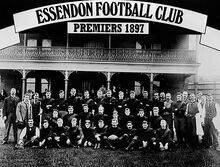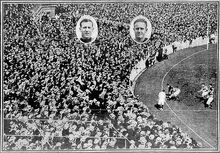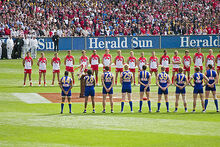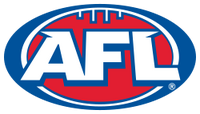The Australian Football League (AFL) is the pre-eminent professional competition in the sport of Australian rules football. Through the AFL Commission, the AFL also serves as the sport's governing body, and is responsible for controlling the laws of the game. The league was founded as the Victorian Football League (VFL) as a breakaway from the previous Victorian Football Association (VFA), with its inaugural season commencing in 1897. Originally comprising only teams based in the Australian state of Victoria, the competition's name was changed to the Australian Football League for the 1990 season, after expanding to other states throughout the 1980s.
The league currently consists of 18 teams spread over five of Australia's six states (Tasmania being the exception). Matches have been played in all mainland states and territories of Australia, as well as in New Zealand and China. The AFL season currently consists of a pre-season competition (currently branded as the "JLT Community Series"), followed by a 23-round regular (or "home-and-away") season, which runs during the Australian winter (March to September). The top eight teams then play off in a four-round finals series, culminating in the AFL Grand Final, which is held at the Melbourne Cricket Ground each year. The winning team in the Grand Final is termed the "premiers", and is awarded the premiership cup. The current premiers are the Western Bulldogs.
History
1897: breakaway VFA clubs found VFL

Essendon won the inaugural VFL premiership by finishing on top of the 1897 round robin finals ladder. A new finals system was implemented during the 1898 VFL season in order that a final match, or "Grand Final", determine the premiers.
The Australian Football League can trace its beginnings to the foundation of the Victorian Football League (VFL) in 1897 when six of the strongest clubs in Victoria—Collingwood, Essendon, Fitzroy, Geelong, Melbourne and South Melbourne—broke away from the Victorian Football Association (VFA) to establish a more professional competition. The six clubs invited two more VFA clubs—Carlton and St Kilda—to join the league for its inaugural season in 1897. Among the notable initiatives established in the new league was an annual finalstournament, rather than awarding the premiership directly to the team with the best record through the season; and, the formal establishment of the modern scoring system, in which six points are scored for a goal, and one point is scored for a behind.
Although the VFL and the VFA continued to compete for spectator interest for many years, the VFL quickly established itself as the premier competition in Victoria. In 1908, the league expanded to ten teams, with Richmond crossing from the VFA and University Football Club from the Metropolitan Football Association. University, after three promising seasons, finished last each year from 1911 until 1914, including losing 51 matches in a row; this was in part caused by its players' focus on their studies rather than football, particularly during examinations, and it was partly because the club operated on an amateur basis at a time when player payments were becoming common. As a result, the club withdrew from the VFL at the end of 1914.
Beginning sporadically during the late 1890s and consistently from 1907 until World War I, the VFL premier and the premier of the South Australian Football League met in a playoff match for the Championship of Australia. South Australia's Port Adelaide was the most successful club of the competition winning three titles during the period along with an earlier victory.
1915-1945: three VFA clubs join VFL between World Wars

In 1924, Footscray, the premiers of the VFA, defeated Essendon, the VFL premiers, in the Championship of Victoria. The result played a large part in Footscray, Hawthorn and North Melbourne gaining entry into the VFL the following year.
In 1925, the VFL expanded from nine teams to twelve, with Footscray, Hawthorn and North Melbourne each crossing from the VFA. North Melbourne and Hawthorn remained very weak in the VFL for a very long period. Although North Melbourne would become the first of the 1925 expansion sides to reach a Grand Final in 1950, initially it was Footscray that adapted to the VFL with the most ease of the three clubs, and by 1928 were well off the bottom of the ladder.
Between the years of 1927 and 1930, Collingwood became the first, and only VFL team, to win four successive Premierships.
1946-1976: Victorian postwar pastime
In 1952, the VFL hosted 'National Day', when all six matches were played outside of Melbourne. Matches were played at the Sydney Cricket Ground, Brisbane Exhibition Ground, North Hobart Oval, Albury Sports Ground and Victorian country towns Yallourn and Euroa.
Footscray became the first of the 1925 expansion teams to win the premiership in 1954.
Melbourne became a powerhouse during the 1950s and early 1960s under coach Norm Smith and star player Ron Barassi. The club contested seven consecutive grand finals from 1954 to 1960, winning five premierships, including three in a row from 1955 to 1957.
Television coverage began in 1957, with direct telecasts of the final quarter permitted. At first, several channels competed through broadcasting different games. However, when the VFL found that television was reducing crowds, it decided that no coverage was to be allowed for 1960. In 1961, replays (in Melbourne) were introduced although direct telecasts were rarely permitted in Melbourne (other States and Territories, however, enjoyed live telecasts every Saturday afternoon).
In 1959, the VFL planned the first purpose built mega-stadium, VFL Park (later known as Waverley Park), to give it some independence from the Melbourne Cricket Club, which managed the Melbourne Cricket Ground. VFL Park was planned to hold 155,000 spectators, which would have made it one of the largest stadiums in the world – although it would ultimately be built with a capacity of 78,000. Land for the stadium was purchased at Mulgrave, then farmland but predicted to be near the demographic centre of Melbourne's population.
The VFL Premiership Trophy was first awarded in addition to a pennant flag in 1959; essentially the same trophy design has been in use since.
In the 1960s, television began to have a huge impact. Spectators hurried home from games to watch replays and many former players took up positions as commentators on pre-game preview programs and post-game review programs. There were also several attempts at variety programs featuring VFL players, who generally succeeded in demonstrating that their skills were limited to the football ground.
The VFL played the first of a series of exhibition matches in 1962 in an effort to lift the international profile of the league.
The 1970 season saw the opening of VFL Park, with the inaugural match being played between Geelong and Fitzroy, on 18 April 1970. Construction work was carried out at the stadium as the 1970s progressed, culminating in the building of the now heritage listed Sir Kenneth Luke stand. The Queen of Australia, Elizabeth II was a guest at the game and officially opened the stadium to the public. The 1970 Grand Finalbetween traditional rivals Carlton and Collingwood, arguably the league's most famous game which saw Carlton recover from a 44-point deficit at half-time to win the game by ten points, featured a famous spectacular mark by Alex Jesaulenko, and was witnessed by a record crowd of 121,696.
1977-1981: VFL leaves Australian National Football Council
In 1976, the National Football League, which was the national administrative body for Australian rules football at the time, established the NFL Night Series to succeed the Championship of Australia. Played concurrently with the premiership season, the Night Series was contested among twelve clubs from the VFL, SANFL and WANFL invited based on their finishing positions from the previous year. The event was mostly played on Tuesday nights, with night games at Norwood Oval in Adelaide, and all games were televised live in colour on Channel 9, which opened up unprecedented revenue streams from television rights and sponsorship opportunities for the sport. The NFL began plans to expand its Night Series to incorporate more teams from the VFL, SANFL and WAFL, as well as state representative teams from other states.
In November 1976, the VFL announced that it was withdrawing from the NFL's competition, having arranged more substantial television and sponsorship deals for its own Night Series for 1977 to be based in Melbourne and feature only the VFL clubs. Light towers were erected at VFL Park specifically for the event.The VFL established a proprietary limited company called Australian Football Championships Pty Ltd in 1978 to run the Night Series, and offered shareholdings to the other state leagues in an attempt to lure other states into the competition.
For the three years from 1977 until 1979, the NFL and AFC competitions were run separately as rival Night Series. In 1978, the Tasmanian representative team competed in both the NFL and AFC series, but all SANFL and WAFL clubs and the minor states teams remained in the NFL Night Series. In 1979, the WAFL clubs and the New South Wales and A.C.T. representative teams defected from the NFL Night Series and joined the AFC Night Series, leaving the NFL Night Series mostly composed of SANFL teams. The NFL Night Series was not revived in 1980, and the SANFL clubs joined the AFC Night Series. Although the NFL itself continued to exist as an administrative body into the early 1990s, the power gained by the VFL as a result of its Night Series take over was one of the first significant steps in its spread interstate and ultimately its take-over (as the Australian Football League) of administrative control of all football in Australia.
In 1980 and 1981, the first years after the NFL Night Series had ended, the AFC Night Series competition was at its largest, with all VFL, WAFL and SANFL clubs plus the four minor states teams (selected under residential qualification rather than state of origin qualification) competing for a total of 34 teams. The size of the competition was reduced from 1982, and thereafter only the top two or three teams from the SANFL and WAFL and the winner of the minor states' annual carnival were invited.
In 1987, the Night Series reverted to only the VFL teams. The competition was pushed earlier into the year, with the final played on 28 April. The following season, the competition did not overlap with the day premiership season at all, and became entirely a pre-season competition. The Night Series is generally considered to be of equivalent importance as the pre-season competition and the VFL Night Series (1956–1971), and records relating to the three competitions are often combined.
With the number of players recruited from country leagues increasing, the wealthier VFL clubs were gaining an advantage that metropolitan zoning and the Coulter law (salary cap) restricting player payments had prevented in the past. Country zoning was introduced in the late 1960s, and whilst it pushed Essendon and Geelong from the top of the ladder, it created severe inequality during the 1970s and 1980s. Between 1972 and 1987, only six of the league's twelve clubs – Carlton, Collingwood, Essendon, Hawthorn, North Melbourne and Richmond – played in Grand Finals.
1982–1989: professionalism, bankruptcy and expansion
See also: Proposed VFL/AFL clubs
The South Melbourne Football Club became the first VFL club to move interstate when it relocated to Sydney in 1982. It was officially renamed the Sydney Swans the following year.
The 1980s was a period of significant structural change in Australian football around the country. The VFL was the most popular and dominant of the state leagues around the country in terms of overall attendance, interest, and money, and began to look towards expanding its influence directly into other states. The VFL and its top clubs were asserting their financial power to recruit top players from interstate. As a result of this, rising cost pressures were driving some of Victoria's weaker clubs into dire financial situations. South Melbourne became the first VFL club to relocate interstate, with the club moving its home games to Sydney in 1982, officially renaming themselves the Sydney Swans the following year. Under the private ownership of wealthy Dr Geoffrey Edelsten during the mid-1980s Sydney became a successful team on-field.
Throughout the 1980s approaches were made by SANFL and WAFL clubs to enter the VFL. Of particular note were approaches by the East Perth Royals in 1980, the Norwood Redlegs in 1986 and 1988,and an East-South Fremantle merger proposal in 1987. None of these attempts were successful despite Norwood trying again in 1990 and 1994.
In 1986, the West Australian Football League and Queensland Australian Football League were awarded licences to field expansion teams in the VFL, leading to the establishment of the West Coast Eagles and Brisbane Bears, who both joined the league in 1987. These expansion team licences were awarded on payment of multimillion-dollar fees which were not required of the existing VFL clubs. In 1989 financial troubles nearly forced Footscray and Fitzroy to merge, but a fundraising event from Footscray supporters stopped the proposed merger at the eleventh hour.
The 1980s first saw new regular timeslots for VFL matches. VFL matches had previously been played on Saturday afternoons but Sydney began playing its home matches on Sunday afternoons and North Melbourne pioneered playing matches on Friday night. These have since become regular timeslots for all teams.
The first National Draft was introduced in 1986 and a salary cap was introduced in 1987
1990-2005: a national competition

The West Coast Eagles and Sydney Swans line up for the national anthem during the 2005 AFL Grand Final. Between 1992 and 2006, non-Victorian clubs won ten out of fifteen AFL premierships.
The league was officially renamed the Australian Football League in 1990 to reflect the new national perspective; the VFA later took over the Victorian Football League name in 1996. Functionally, the AFL gave up control over its Victorian-based minor grades at the end of 1991 – clubs continued to field reserves teams in the independent Victorian State Football League.
In 1990, the SANFL's most successful club, Port Adelaide, made a bid for an AFL licence. In response, the SANFL established a composite South Australian team called the Adelaide Crows, which was awarded the licence and joined the league in 1991 as the fourth non Victorian club. The same year saw the West Coast Eagles become the first non Victorian club to reach the Grand Final, which was won by Hawthorn. The Eagles would then win the premiership in 1992 and 1994. In 1994, the Fremantle Football Club was formed in Western Australia, and joined the AFL in 1995, becoming the fifth non Victorian club.
In 1996 several Victorian clubs were in severe financial difficulties, most notably Fitzroy and Hawthorn. Hawthorn proposed to merge with Melbourne to form the Melbourne Hawks but the merger ultimately fell through and both teams continued as separate entities. Fitzroy, however, was too weak to continue by itself. The club nearly merged with North Melbourne to form the Fitzroy-North Melbourne Kangaroos but, after the other clubs voted against it, the club merged with Brisbane to become the Brisbane Lions.[15] Fitzroy played its last match at the end of 1996. With the Brisbane-Fitzroy merger, Port Adelaide was awarded an AFL licence and joined the league in 1997.
Through the 1990s there was a significant trend of Melbourne-based teams abandoning the use of their small (20,000–30,000 capacity) suburban venues for home matches in favour of the larger MCG and Waverley Park. The 1990s saw the last matches played at Windy Hill (Essendon), Moorabbin Oval (St Kilda), Western Oval (Footscray) and Victoria Park (Collingwood) and saw Princes Park abandoned by its long-term co-tenant Hawthorn. The transition to the use of only two venues in Melbourne was ultimately completed in 2005 when Carlton abandoned the use of Princes Park. In 1999, the league sold Waverley Park stadium and used the funds in a joint venture to begin construction of a brand-new stadium situated at Melbourne's Docklands. Representative state football came to an end, with the last State of Origin match held in 1999.
2006–present: new frontiers
In the late 2000s, the AFL looked to establish a permanent presence on the Gold Coast in the state Of Queensland, which was fast-developing as a major population centre. North Melbourne, which was in financial difficulty and had played a few home games on the Gold Coast in previous years, was offered significant subsidies to relocate to the Gold Coast but declined. The AFL then began work to establish a club on the Gold Coast as a new expansion team.
Early in 2008, a meeting held by the AFL discussed having two new teams enter the AFL competition. In March 2008, the AFL won the support of the league's 16 club presidents to establish sides on the Gold Coast and in Western Sydney. The Gold Coast Suns were established and joined the AFL in 2011 as the 17th team. The Greater Western Sydney Giants, based in both Western Sydney and Canberra, were then established and entered the league as the 18th team in 2012.
On 25 April 2013 the Westpac Stadium in Wellington, New Zealand hosted the first ever Australian Football League game played for premiership points outside of Australia. The night game between St Kilda and Sydney was played in front of a crowd of 22,183 on Anzac Day to honour the Anzac bond between the two countries.
A national women's league comprising a subset of AFL clubs began in 2017. Thirteen AFL clubs placed bids to participate in the women's competition. Eight clubs - Adelaide, Brisbane Lions, Carlton, Collingwood, Fremantle, Greater Western Sydney, Melbourne and the Western Bulldogs - were granted licences to participate in the inaugural season.
On the 14th of May 2017, Port Adelaide and the Gold Coast Suns played the first ever AFL match for premiership points in Shanghai, China, attracting a crowd of 10,114 at Jiangwan Stadium. Port Adelaide won the game by 72 points.
Clubs
Current clubs
Former Clubs
| Club | Nickname(s) | Home ground | Years in AFL | Reason for leaving |
|---|---|---|---|---|
| Brisbane | Bears | Carrara Stadium (1987–1992) The Gabba (1991–1996) |
1987 → 1996 | Merged to become the Brisbane Lions |
| Fitzroy | Lions | Princes Park (1987–1993) Western Oval (1994–1996) |
1987 → 1996 |


